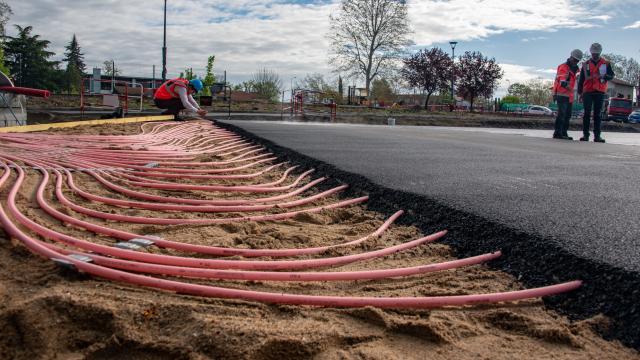Road departments deploy plow and salt trucks to keep roads clear and safe this time of year. But that safety comes at a cost, in the form of damage to infrastructure and cars. One possible solution to this problem is a road that can heat and cool itself. It’s a clever innovation but it has a massive catch.
Eurovia, a subsidiary of the Vinci construction company in France, is experimenting with its Power Road. It works using tubing installed as a heat exchanger under the road. The tubes absorb heat in the summer and release heat in the winter. The end result is a road that can keep itself cool in the summer and to a balmy 140 degrees Fahrenheit (60 degrees Celsius) in the winter. Who needs plows and salt when your road is warmer than a hot tub?
The warmth gathered in the tubes can also be used to heat nearby buildings, provide warm water or heat swimming pools.
Eurovia’s Power Road is years into its testing, with a few projects scattered around France. The latest implementation was kicked off in Égletons, about 483 km south of Paris. A 120.09 m stretch of Power Road is connected to the city’s biomass-fired heating network, and the 20 Minutes news site reports the road is already doing a great job.
Le froid sévit dans le @Departement19, mais certaines de ses #routes sont moins glissantes que d’autres ????❄️
????️#PowerRoad d’#Eurovia se montre plus efficace que jamais contre le #verglas et la #neige : l’#innovation au service de la #securitéroutière et de l’#environnement ! ⤵️ pic.twitter.com/EEHooYJ8lk— Eurovia (@Eurovia_Group) January 15, 2021
You may wonder why something like this even exists when road salt and ploughing are cheap (and generally good enough).
Snow removal and road de-icing is a menace to vehicles and infrastructure. Here in North America, a study by AAA found road salt damage can cost car owners as much as $US3 (A$4) billion annually. But it doesn’t just stop with damage to our beloved cars. Road salt is known to cause great damage to highways and bridges, reports the Columbus Dispatch. Where I live, it’s also not uncommon to see plow trucks scraping up chunks of road surface, creating potholes. If all of that isn’t bad enough, road salt also gets into our lakes, rivers and drinking water.
That’s where an innovation like this can save the day. But it comes at a big cost. That 120.09 m stretch of Power Road costs €250,000 (about $US303,000 (A$399,809)) more than a regular road. A single mile could cost millions more than a conventional road. So it’s a neat concept, but it’s so expensive that I can’t see it taking plow trucks off of the road. I also think it’s too expensive to make its other proposed benefits — like heating a swimming pool — worth it.
This isn’t the first idea like this. Solar roadway projects also promise a somewhat similar outcome of making roads doing multiple jobs. But they’re likewise too expensive to make any real headway.
I think this is an awesome technology and it still has some use — it could make bridges safer — but I don’t see it replacing road salt, plows or your furnace anytime soon.
